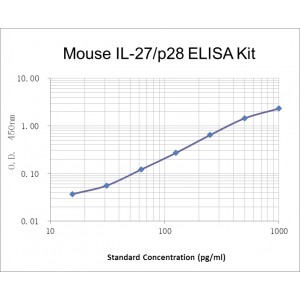More info
Assay Range | 15.6 - 1,000 pg/mL |
Sensitivity | 10.0 pg/mL |
Size | 96T |
Storage | Store at 2 - 8ºC. Keep reconstituted standard and detection Ab at -20 ºC |
Assay Principle | Sandwich ELISA |
Sample Volume | 100 µL final volume, dilution factor varies on samples |
Detection Method | Chromogenic |
Kit Components
1. Recombinant Mouse IL-27 standard: 2 vials
2. One 96-well plate coated with anti- Mouse IL-27 Ab
3. Sample diluent buffer: 12 mL - 1
4. Detection antibody: 130 µL, dilution 1:100
5. Streptavidin-HRP: 130 µL, dilution 1:100
6. Antibody diluent buffer: 12 mL x1
7. Streptavidin-HRP diluent buffer: 12 mL x1
8. TMB developing agent: 10 mL x1
9. Stop solution: 10 mL x1
10. Washing solution (20x): 25 mL x1
Background
Interleukin 27 (IL-27) is a non-covalently linked heterodimeric cytokine that is composed of an Epstein-Barr virus-induced molecule 3 (EBI3) subunit linked with the IL-27 p28 subunit. IL-27 p28, also known as Interleukin-27 subunit alpha (IL-27A), or IL-30, is a 28 kDa glycoprotein belonging to the type I cytokine family. Mouse p28 shares 74% aa sequence identity with human counterpart.
IL-27 is expressed by monocytes, endothelial cells and dendritic cells. IL-27 binds to a heterodimeric receptor complex of WSX1/TCCR and gp130 to initiate a series of biological processes. WSX-1 is specific for IL-27 and is expressed on resting/naive CD4+ T cells, CD8+ T cells, NK cells, dendritic cells, monocytes, mast cells, and B cells. gp130 is a common component of the receptor complexes for many other cytokines and is widely expressed by a variety of immune and non-immune cells. IL-27 has exhibited multiple activities in immunoregulation. For instance, it can regulate T-helper cell development, suppress T-cell proliferation, stimulate cytotoxic T-cell activity, and plays a role in inducing isotype switching in B-cells. It also triggers interferon-gamma/IFN-gamma production in naive CD4 T-cells by cooperating with IL-12.


